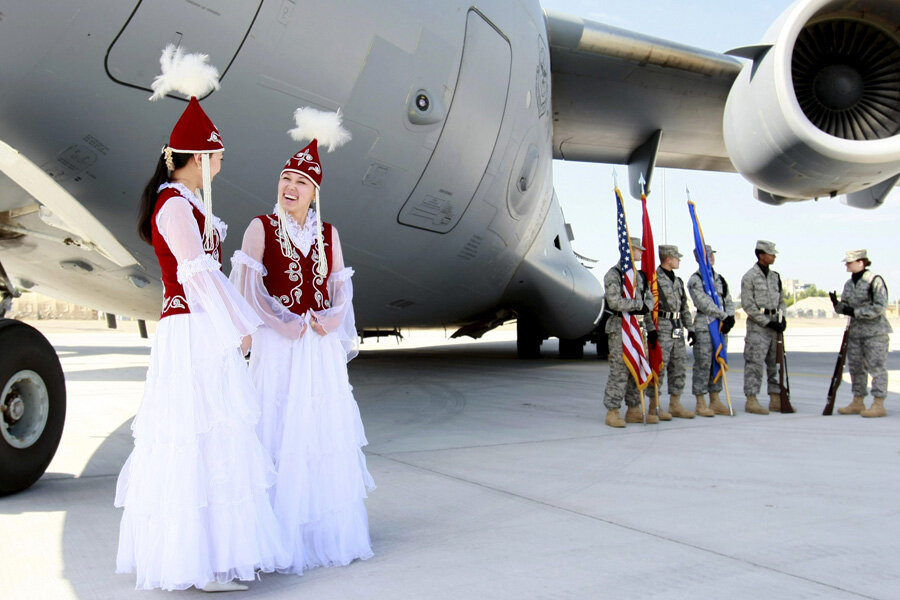Why closure of Kyrgyzstan air base is point of no return for Afghan war
Loading...
When President Barack Obama announced that fewer than 10,000 US troops would remain in Afghanistan beyond the end of this year (and that depending on the permission of the next Afghan president) and that all troops would be gone by 2017, his decision was attacked in various corners as a retreat, a failure, a gift to the Taliban.
The Washington Post editorial page decried the decision as "cutting and running." Republican Sens. John McCain and Lindsey Graham attacked the timetable as a "monumental mistake and a triumph of politics over strategy."
What the criticism often ignores is that if vast numbers of foreign troops in Afghanistan – NATO had 140,000 troops there as recently as 2011 – haven't been able to defeat the insurgency, it's hard to see what 10,000 or so, with a mission limited to training and counterterrorism, would be expected to accomplish if they stayed indefinitely.
But a piece of news this week also shows that even if a larger and longer deployment was being considered, it's just grown much more expensive and difficult. Nearly impossible, in fact, unless there's a major geopolitical shift.
On Tuesday, the US handed over the Manas Transit Center in Kyrgyzstan to the government there, which came to power after a popular uprising against pro-Western President Kurmanbek Bakiyev in 2010. The new government tilts very strongly toward Russia. Kyrgyz President Almazbek Atambayev, elected in 2011, responded to Russian pressure by pledging that he'd shut the US base. Yesterday's closure was a fulfillment of that promise.
How important has Manas been to the US and NATO war effort in Afghanistan? Reuters reported from the base yesterday that it was used to move "more than 5.3 million servicemen in and out of Afghanistan and handled tens of thousands of cargo shipments and refueling missions."
"We were known as the gateway to Afghanistan on freedom's frontier," Col. John Millard, commander of the 376th Air Expeditionary Wing and Manas base head, told visiting reporters on Monday, according to Reuters. "We offloaded more than 1 billion liters of fuel to 136,000 coalition aircraft.... We like to say we fueled the fight.... We literally moved 98 percent of all ISAF and coalition forces into and out of Afghanistan." The International Security Assistance Force, or ISAF, is the name for NATO forces in the country.
That fuel is now gone, for good.
The 2010 uprising in Kyrgyzstan and its aftermath is an interesting mirror image of the recent turmoil in Ukraine, where a popular uprising against a pro-Russian president who was spectacularly corrupt brought a Western-leaning government to power in Kiev.
Mr. Bakiyev and his coterie, too, were spectacularly corrupt, and just as ousted Ukrainian President Viktor Yanukovych lined his pockets thanks to sweetheart deals with Russia over energy, his fallen Kyrgyz counterpart also extracted maximum value around the fuel supplies heading to Afghanistan for the war. At the height of the war, Bakiyev was estimated to be skimming about $170 million a year off the top of NATO fuel passing through Manas.
In 2001, Russia gave its assent to using its former imperial positions in Central Asia to support the Afghanistan war. Much has obviously changed in the past decade, and Putin came to see the presence of NATO troops in its near abroad as much bigger threat than heroin flooding his country from Afghanistan or jihadis on the doorstep of former Soviet possessions. Last year Putin promised to write off $500 million in Kyrgyzstan debt to his country, while securing a 15-year extension on Russia's lease of Kant airbase in the country.
That's proven a quiet victory from Moscow, as the US quietly departs from what was once the logistics hub for the Afghan war.








